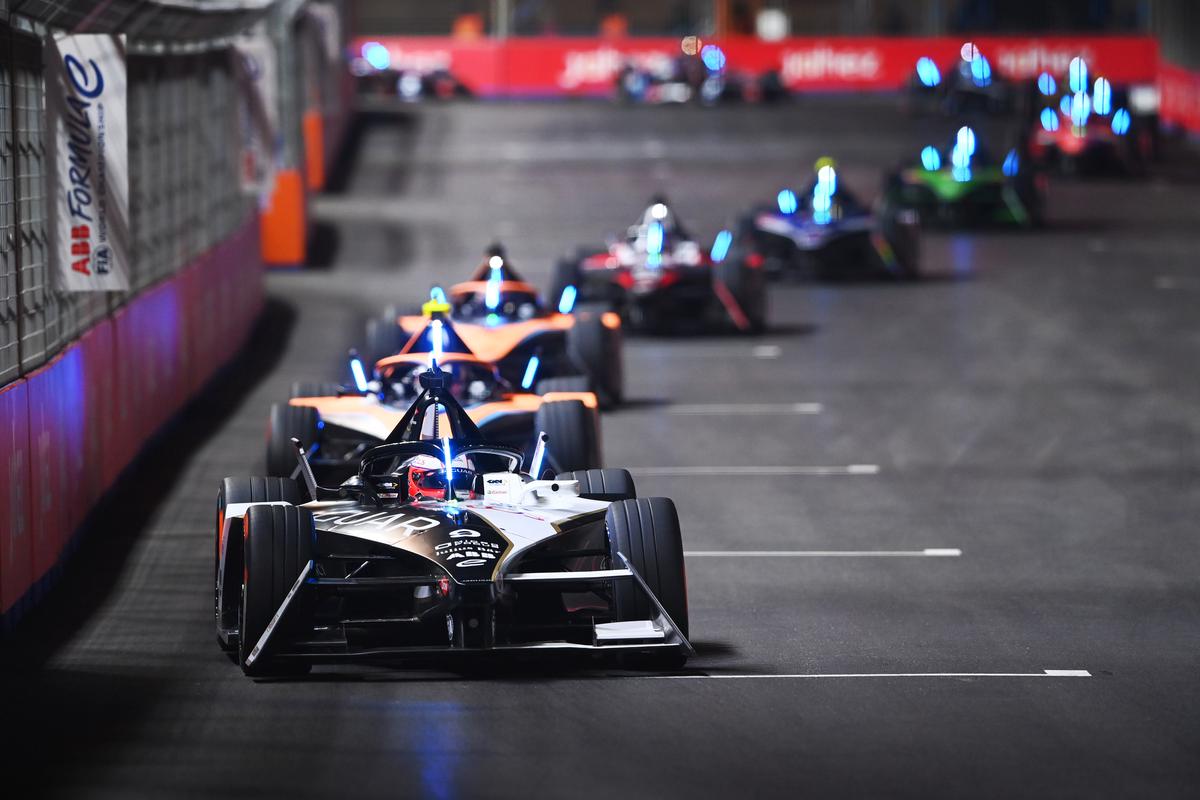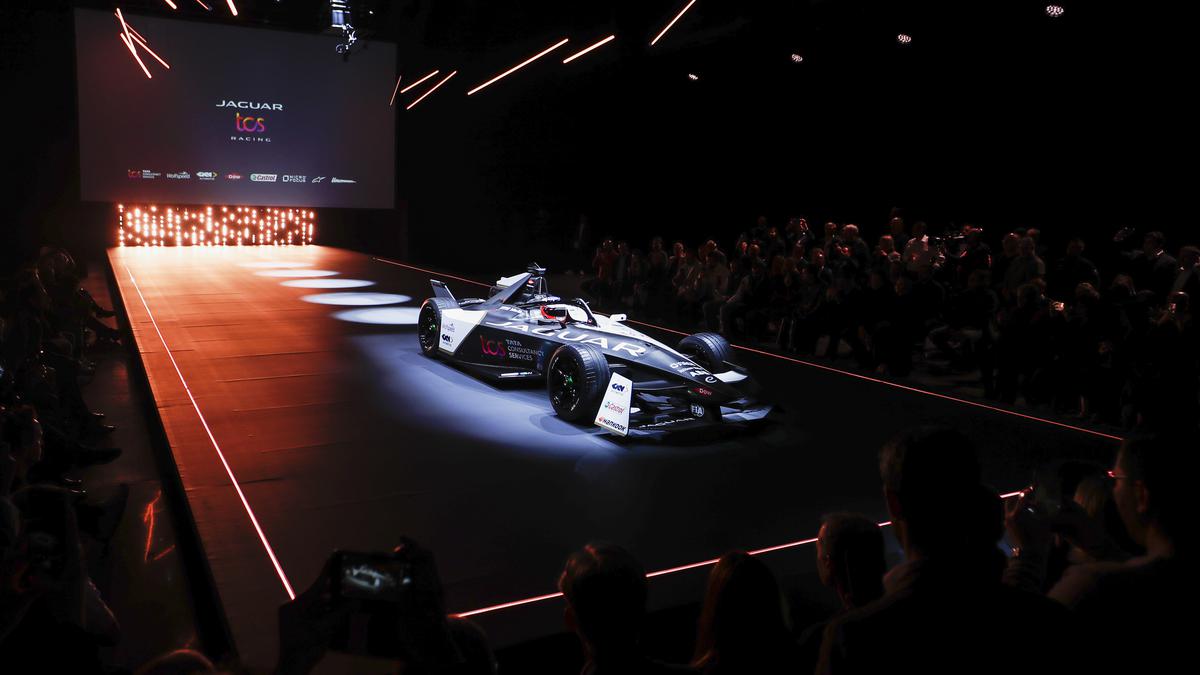
Cutting-edge technology: Formula E claims this year’s machine is the most efficient formula racing car ever, with more than 40% of the energy used within a race produced by regenerative braking. Photo credit: Getty Images
A Federation Internationale de l’Automobile (FIA) world championship event returns to India this weekend for the first time since the Buddh International Circuit in Greater Noida hosted the third and final Indian Grand Prix Formula One race ten years ago.
But this time, the vrooming, naturally aspirated V8 engines give way for a more eco-friendly, fully electric powertrain as the FIA Formula E World Championship makes its Hyderabad debut.
As India prepares to get back on the world motorsport calendar with this race, The Hindu offers you a primer on what to expect and what the championship is all about.
• Origin story and series arc
Formula E — the first single-seater, all-electric championship — was started in 2014-15 to promote sustainable mobility and electric vehicles. The series received world championship status from the FIA ahead of the 2020-21 season.
The open-wheel, open-cockpit racing series is powered by an electric motor instead of an internal combustion engine.
Since its debut, the series has seen the cars evolve, with the third generation of vehicles introduced ahead of the current season, which began in Mexico City in January.
In a bid to take the races to the people, Formula E stages them on the streets of various cities rather than in purpose-built circuits, which are usually located outside the main population centres.
In the first four seasons, a driver had to use two cars to complete a race, as the battery pack capacity was limited to 28kWh and had 200kW of power output. The drivers swapped cars in the pitlane mid-race.
But from season five, with a bigger battery pack of 54kWh and a power output of 250kW, a driver could go the whole distance in a single car.
Over the years, the car’s ability to harvest energy from braking to charge the battery has improved manifold.
• A new generation: the Gen3 car
For the 2022-23 season, Formula E unveiled its most technically advanced car with a power output of 350 kW (470 bhp), far higher than the 250kW available in Gen2 cars.
This year’s cars are a radical departure from the first two generations. Apart from the higher power output, the cars have two electric motors, one attached to the front axle and the other to the rear. The new front powertrain adds 250kW to the 350kW at the rear, more than doubling the regenerative capability of a Gen2 car to a total of 600kW.
More importantly, the cars have no rear mechanical brakes, with the braking accomplished mainly by the electric motor. With no rear brakes, the car’s weight has also significantly reduced by almost 60kg.
A lighter body and more powerful powertrain mean these cars can hit a top speed of 322 kmph (200 mph), but this is unlikely to be seen during race weekends since the series races mostly on street circuits where it is difficult to find long straights.
Formula E claims it is the most efficient formula racing car ever, with more than 40% of the energy used within a race produced by regenerative braking. The sport has also focused on using sustainable materials for the chassis, batteries and even tyres.
• The competitors
With governments worldwide set to phase out internal combustion engine vehicles, automobile manufacturers have been scurrying to offer electric cars in their portfolios.
Formula E has benefited from this proposed change, with many major car companies spending vast sums to use the series as a testing ground for the development of electric vehicles.
While a few companies have come and gone — Mercedes, BMW and Audi — there are still some big names, including Jaguar, Nissan, Porsche, Maserati and India’s Mahindra, which has been operating since the inaugural season.
• The race weekend format
Formula E introduced a new qualifying system last year: the duels format. The 22 drivers are slotted into two groups based on the championship standings, with drivers in odd positions in one group and those in even places in the other.
The top four from each group progress to the quarterfinals, followed by the semifinals, before the group toppers battle it out for pole position. The top eight places are set through this format, with the driver on pole position getting three points.
Drivers from the pole-sitter’s group who did not qualify for the duels fill the odd-number grid positions from ninth, with the fifth-fastest driver in that group in the first stage of qualifying starting ninth.
From 2023, there will be a fixed number of racing laps depending on the track length, and in case there are safety-car periods or yellow flags, the race director will add laps to compensate.
Qualifying and the main race are held on the same day, usually the Saturday of a race weekend, with two practice sessions, one on Friday and another on Saturday.
In the past, Formula E used a feature called Fan Boost, in which five drivers with the most fan-votes online received a burst of extra power which could be activated for a five-second window to defend or overtake. It has now been discontinued. Another feature was allowing drivers to go off track to collect more power so that a driver could strategically use that extra power later in the race despite losing time while going off the racing line.
• The story this season
Hyderabad is the third venue of the championship, but the fourth race, as Riyadh hosted a doubleheader. The 2.8km Hyderabad Street Circuit is situated around the iconic Hussain Sagar Lake.
German Pascal Wehrlein, driving for the Porsche team, leads the drivers’ standings with 68 points after two wins in Riyadh, six points ahead of Jake Dennis in the Avalanche Andretti Formula E team.
Mahindra Racing had a good start, with former Formula E champion Lucas De Grassi taking pole in the first race in Mexico City and finishing third. However, the team scored no points in Riyadh and will hope for a better outcome in its home race.
• What the future holds
When Formula E began in 2014-15, it was seen as a place for F1 drivers without a seat to prolong their racing careers. But with big money entering the picture, the series has started to attract young drivers. Even though F1 is the ultimate aim for most single-seater drivers, Formula E has become an attractive alternative.
Last year, 2020-21 Formula E champion Nyck de Vries had a one-off outing for the Williams F1 team in the Italian GP and converted that into a full-time F1 seat with AlphaTauri for 2023.
Even as the sport has seen an uptick in television ratings, its popularity can’t be compared to other established series. One major factor holding it back is the lack of the ‘wow factor’ of high-speed action. As the technology evolves and cars become faster, the sport will need to revisit its ‘only street circuit’ approach and think about unleashing these machines on a few iconic race tracks. But for now, with the sport going to new places such as India, it has the potential to boost its profile and build a new fanbase on the back of successful outings.
For all the latest Sports News Click Here
For the latest news and updates, follow us on Google News.

